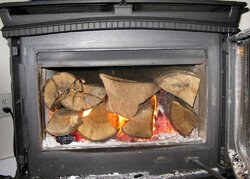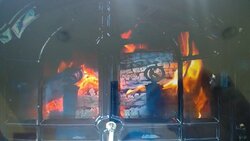OK, I've got a Rutland magnetic thermometer for my NC-30. I put it on the angle of the step and the first real fire (other than break-in fires) ran away to 800*. I shut the air down at 600* and it kept climbing. At 800* I put foil over both air intakes and it slowly cooled down. I turned the lights down low and did not see anything on the outside of the stove glowing when it was at 800*. Today I put a strip of foil tape over the secondary air intake and it seems to be behaving a bit better.
The particulars are . . . Outdoor temps in the 20s. 27 feet of Flex King liner, 90* elbow, 24" of horizontal, another 90* elbow and 22" of black single wall to the stove. I'm burning oak that has been dead in the woods for years, cut, split and sat for one summer/fall.
Now I have a ton of questions:
*The Rutland thermometer shows anything over 550* as overfire. From what I read on these forums it seems like normal operating temps can be higher than that. What is the high end of "good burning temps"?
*Where should I put this thing? stove deck? on the angled part of the step? on the pipe?
*If the thermometer says 800 but the metal isn't glowing should I be worried about damage?
*Is it OK for internal metal parts to glow?
*When the temp ran up to 800* the inside of the firebox was curiously dark. There was a few glowing coals, and a lot of secondary flames but most of the wood was dark and the bricks were still blackened. Is this the way this is supposed to work? When my Montpelier gets rockin' the firebricks clean up nicely (although maybe I'm overfiring this one too but since it's an insert there's no good place for the thermometer.
*I've read a post or two that indicates that filling the firebox can cause an overfire - so how does one get a good overnight burn if you can't fill the box?
Thanks in advance. . .
The particulars are . . . Outdoor temps in the 20s. 27 feet of Flex King liner, 90* elbow, 24" of horizontal, another 90* elbow and 22" of black single wall to the stove. I'm burning oak that has been dead in the woods for years, cut, split and sat for one summer/fall.
Now I have a ton of questions:
*The Rutland thermometer shows anything over 550* as overfire. From what I read on these forums it seems like normal operating temps can be higher than that. What is the high end of "good burning temps"?
*Where should I put this thing? stove deck? on the angled part of the step? on the pipe?
*If the thermometer says 800 but the metal isn't glowing should I be worried about damage?
*Is it OK for internal metal parts to glow?
*When the temp ran up to 800* the inside of the firebox was curiously dark. There was a few glowing coals, and a lot of secondary flames but most of the wood was dark and the bricks were still blackened. Is this the way this is supposed to work? When my Montpelier gets rockin' the firebricks clean up nicely (although maybe I'm overfiring this one too but since it's an insert there's no good place for the thermometer.
*I've read a post or two that indicates that filling the firebox can cause an overfire - so how does one get a good overnight burn if you can't fill the box?
Thanks in advance. . .



